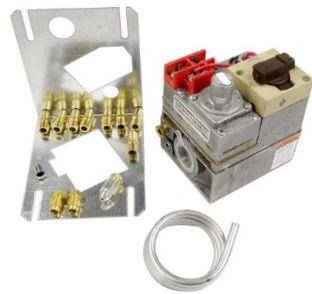FREE Standard Shipping On All Orders $100 or More!*
Converting a Pool Heater from Propane to Natural Gas
Converting your gas pool heater from propane gas (LPG) to natural gas, or the other way around, is not so complicated. Pool heaters can operate on either fuel, but you can't just switch gas without changes to the orifice sizes.
This is because propane gas has a different heating value than natural gas and the orifices for the pilot, gas valve and burner tray are smaller when using propane gas. The two gases are also under a different pressure, controlled by specific gas regulators.
If you are converting a Laars heater, there is no kit available. Laars (Jandy) heaters will require a burner tray replacement. The burner tray for propane that KobiCalvert needs to use will have smaller orifices for the pilot, the gas valve, and all of the burner orifices for each burner.
Kobi could buy the burner orifices, pilot and gas valve separately, but it may be cheaper to buy the entire burner tray. He may want to consider replacing the heater, given the age of it. The new parts will cost as much as half the cost of a new heater. Although a burner tray replacement is putting many new parts into your old heater, the heat exchanger, control circuitry, the insulation and other components will still be nearly 15 years old.
So, again for Laars (Jandy) heaters, you will need to replace the burner tray, or buy the gas valve, pilot and burner tray orifices separately. For other manufacturers, including Pentair (Purex), Hayward and Raypak, you can buy a pool heater conversion kit, either natural to propane or propane to natural.
Some of the gas conversion kits for heater manufacturers other than Laars (Jandy) have inexpensive kits that allow you to change the orifices inside of the gas valve. These are the cheapest kits. Other conversion kits may include a new gas valve.
Look in our Pool Heater Parts department to find your particular pool heater and locate the conversion kit in the "parts not shown" section at the bottom of the page.
Gas heater conversions should be done by a qualified gas contractor. It's not that it's overly technical, but it can be dangerous if a heater is converted improperly or without attention to detail.